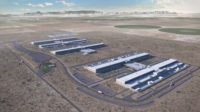Materials
Meta Tests AI-Developed Lower-Carbon Concrete on Data Center Project
Workers pour the test concrete mix for an office slab at Meta's DeKalb, Ill., data center project.
Photo courtesy of Meta
While Facebook parent company Meta has drawn attention for its efforts to create a virtual “metaverse,” the company is also focusing on the impact of its real-world buildings.
Meta is working with researchers at the University of Illinois at Urbana-Champaign to create concrete mixes with lower embodied carbon emissions using an artificial intelligence model. The company has already tested one mix at a data center construction project in Illinois, and is planning more pilots at some of its other projects currently underway, says Amruta Sudhalkar, data center sustainability project manager at Meta.
The researchers, led by professors Lav Varshney of the university’s electrical and computer engineering department and Nishant Garg from its civil engineering department, trained an AI model using concrete compressive strength data from University of California, Irvine’s Machine Learning Repository and embodied carbon data from the World Business Council for Sustainable Development’s Cement Sustainability Initiative, Meta said in a blog post written by Sudhalkar and research scientist Julius Kusuma. The AI generated dozens of potential concrete formulas much faster than would have otherwise been possible, according to Meta.
Industry Effort
Meta’s effort comes at a time when the emissions impact of buildings and construction are receiving increased attention. U.S. Environmental Protection Agency data show that cement manufacturing accounts for 1.25% of U.S. carbon dioxide emissions. Julia Garbini, executive director of the Ready Mixed Concrete Research & Education Foundation, said in a statement that the concrete industry has been working to reduce its carbon intensity throughout the value chain. Last fall, the Portland Cement Association also shared its “roadmap to carbon neutrality,” which includes plans from production to construction and in use in buildings and infrastructure.
“High profile efforts from companies like Meta demonstrate leadership among construction owners about the many levers we can use to reduce concrete’s impact, not only at the embodied carbon stage but throughout the full life cycle,” Garbini said.
Sudhalkar says Meta began to focus on the concrete used in its data centers after a company lifecycle assessment showed that concrete contributes significantly to its data center construction-related emissions.
The Urbana-Champaign researchers selected five of the AI-generated formulas to test in a lab, based on sustainability metrics including carbon emissions, water usage and acidification potential, as well as predicted strengths, Sudhalkar says. Ozinga, Meta’s concrete supplier for its DeKalb, Ill., data center project, then further tested and refined the formulas and made adjustments based on local material availability and the needs related to cold weather expected at the northern Illinois location. It settled on a mix that achieved 57% cement substitution with a combination of fly ash and slag.
Meta is not treating the mix as proprietary, and the exact makeup will be published in an upcoming research paper, according to Sudhalkar. Collaboration on the paper also included researchers from the MIT Concrete Sustainability Hub and IBM’s Watson Research Center.
Real-World Test
The $800-million DeKalb data center is currently under construction, and Meta announced April 27 that it would expand it beyond the original plans, more-than-doubling the square footage and increasing the project from two buildings to five.
To test the mix, Ozinga placed about 640 cu yd of it for two floor slabs at the DeKalb project site, mostly for a temporary construction management office and also for a guard shack.
Ryan Cialdella, vice president of innovation and market development at Ozinga, says that the collaboration allowed the supplier to work with all the stakeholders from the end user down and make needed tweaks with support from everyone involved. Ozinga has continued developing lower-carbon mixes that will be used on additional data center buildings.
“We can continue to use the field data, feed it back through the AI model and refine it to continue to push the boundaries on carbon reduction,” he says.
Sudhalkar says Meta aims for 4,000-psi concrete after 28 days. To enable faster construction, the company typically wants to achieve 3,000 psi after five days. However, the test mix achieved just 2,650 psi at the five-day mark, so the team will next focus on optimizing its mix for early strength gain, possibly by including non-chloride admixtures to help accelerate curing. She adds that the mix used on the project would actually perform better in warmer climates.
To account for geographic conditions and material availability, Meta is investigating other cement substitutes like ground glass, as well as the use of recycled aggregates as another way to reduce its carbon footprint, Sudhalkar says. Meta has multiple pilot projects to test other varieties of lower-carbon concrete underway, including its data centers in Tennessee and Nebraska.







